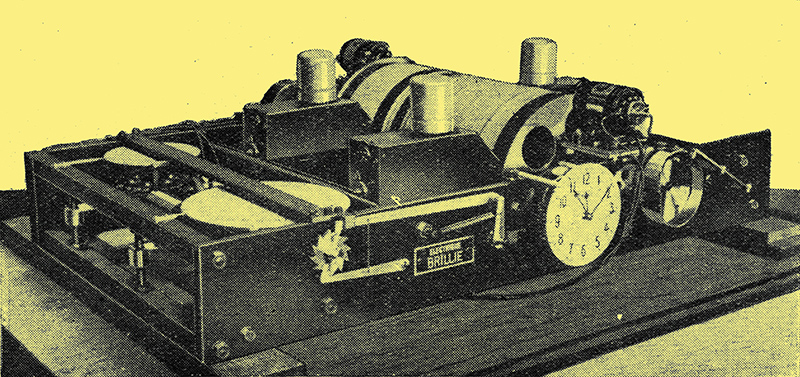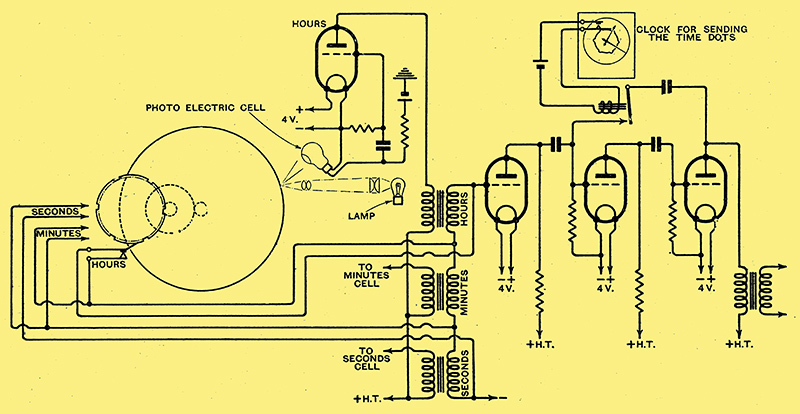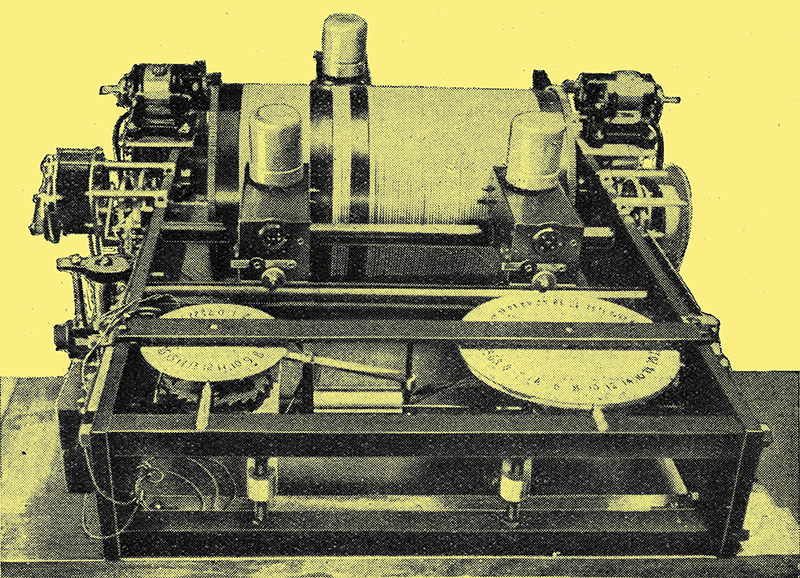|
The speaking clock and how it works.
Odeon 8400, s'il vous plait! calls the modern Parisian, and in a few-moments a clear voice hat the other end of the phone gives him the correct time in hours, minutes and seconds. The ingenious mechanism of the - speaking clock - is here described.

This side view of the speaking clock shows, in addition to the dial, the second control cam for actuating the time pips every ten seconds.
Particularly interesting and ingenious use is made of well-known principles in the recently installed time-by-telephone service in Paris. This system makes accurate time available to everyone over the ordinary telephone lines, and is completely automatic. Although the subscriber ringing up hears a voice repeating the hours, minutes and seconds, no human agency whatever is employed.
The system was devised by the famous French clock manufacturers, Brillie Freres, and has become known as the speaking clock. Every ten seconds it can be heard announcing the time, and the exact moment is indicated by pips similar to those heard in the BBC time signals. The various announcements made by the clock were recorded on strips of paper ⅛ in wide by the method used in the production of ordinary talking films. Separate strips are used for each hour, minute and seconds announcement. These strips, ninety in all, are fastened parallel to each other around a rotating cylinder. They are arranged three groups, one of twenty-four for the hours, one of sixty for the minutes, and a third of six for the seconds, the latter including a special phrase which is heard at the full minute.
Opposite each group is a chamber containing a lamp, an arrangement of lenses by means of which the lamp filament is focused on to the strip, and a photo-electric cell. The photo cell receives the light reflected from the strip as it revolves on the cylinder, and the variations of current thus set up are amplified by a three-electrode valve. The anode supply of this valve is fed through a low-frequency transformer, the secondary of which goes to the input side of a three-valve RC coupled amplifier. There is a separate valve and transformer for each group, but the secondaries of the three transformers are joined in series.

A circuit diagram of the speaking clock and its main amplifier. The photocell receives light reflected by rotated strips of paper on which the time announcements have been recorded..
During a single rotation of the cylinder the hour, minute and second strips which happen to be opposite their respective photo cells will simultaneously impress their announcements on the circuit. If these were all allowed to proceed via the secondaries of the transformers and the amplifier to the subscribers the result would be an unintelligible jumble of the three phrases associated-with any specific time for instance, 'Quinze heures, Cinq minutes and Dix secondes' would be heard simultaneously.
To overcome this the secondary of each trans-former is-given a short-circuiting contact, controlled by a cam operated by the cylinder. The cam is arranged to close two of these contacts at any time, leaving the third open. Therefore, when the three phrases occur simultaneously two of them are rendered ineffective by the shorting of the secondaries into which they are induced, while the third goes through without interference. The three phrases are repeated simultaneously three times, and the cam operates to short-circuit two different secondaries each time, so that the effective result is that the three required phrases are allowed to pass through to the amplifier only at the appropriate moments.
The method of producing the musical note for the pips which indicate the exact moments is also ingenious. A cam driven by a standard clock is made to close a contact at the exact moments when the pips are required. The closing of this contact joins the anode of the third valve in the amplifier to the grid of the second valve, via a capacitor, and thus sets the circuit into LF oscillation, producing the note which is heard.
Subscribers could be joined to the output of this amplifier, but if more than one person were connected at the same time they would be able to speak to each other. To obviate this sixty one-valve units are used, each taking its input from the main amplifier. Thus, sixty subscribers may ring up simultaneously, each one being separately connected to the output of one of these small units.
Asking the Time

A closer view of the clock showing the rotating drum and the photocell chambers. The associated dials indicate to an observer whether the clock is functioning correctly.
When a subscriber is connected, a relay, with three contact points, is actuated. One of these brings into action a meter to record the number of calls; the second connects an accumulator to the filament of the valve, while the third connects up the batteries to the valves and photo cells at the main amplifier, if these are not already in circuit. A reserve valve is provided in each unit, and, if the working valve burns out, the cessation of its current operates a relay which automatically brings the reserve valve into circuit, and enables it instantly to assume the function of the burnt-out valve.
The whole apparatus has been given a telephone number (Odeon 8400), and any subscriber calling up that number is put straight through to the clock.
|